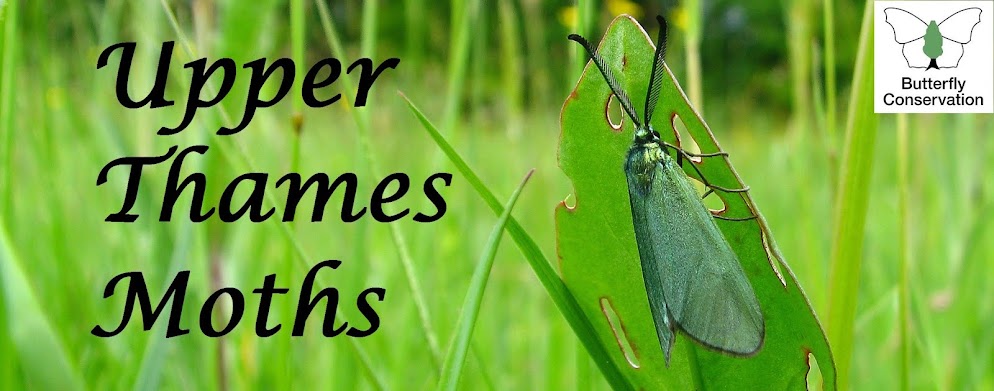On the 30th, I visited Aston Rowant (sticking to the north side of the motorway), and although it was rather cloudy, the wind mercifully dropped for a bit and I found a few micros. Quantity was provided by Ancylis comptana in its thousands across the main slope, and plenty of Aethes tessarana. Other interesting ones were: Dingy White Plume (a few flushed from most of the larger marjoram patches), Scythris crassisicula (a few adults sat on the rock rose), Cistus Forester (2), Crescent Plume (lots in a big patch of restharrow), Coleophora lixella (one adult), Mompha miscella, Teleoides sequax (adults and vacated spinnings) and Grapholita janthinana, as well as more early Stephensia brunnichella mines.
 |
| Coleophora lixella - Aston Rowant |
I also visited Sydlings Copse and found a Tawny Shears larva on Bladder Campion, a new one for me, as well as a mine of the little elachistid Perritia obscurepunctella on Honeysuckle. Trapping there in the evening with some LEDs (2 on the 'heath' and 2 in the fen) sadly didn't produce the hoped for Dentated Pug among the abundant Yellow Loosestrife, but a few other nice things: Dotted Fan Foot, Round-Winged Muslin, Pine Hawk, Minor Shoulder-Knot, Blackneck, Brown Scallop, Kent Black Arches, Small Emerald, Pexicopia malvea and Epinotia cruciana among 81 species. There were also a couple of extras that I think will need the chop - a Monochroa sp. and lots of a Phalonidia sp. Another day time trip later in the week to Sydlings Copse also produced an impressive final instar Puss Moth larva, lots of Nemophora metallica, and what I think is Nemophora cupriacella as opposed to minimella.
 |
| Kent Black Arches - Sydlings Copse |
 |
| Nemophora cupriacella - Sydlings Copse |
Yesterday I had a brief walk at Chilswell Valley as well, and in rather windy conditions swept a couple of Small Emeralds from low-growing traveller's joy, and a surprise Trifurcula sp. that will need the chop.

Hello Will,
ReplyDeleteSome very nice micro sightings there. You visiting the Chilswell Valley reminds me that now is the time to look for Grapholita pallifrontana on wild liquorice. I presume you didn't see any there as you didn't mention it? I was told the other day of a new site for the plant in north Bucks which I'll need to go and check out when/if we get some sunshine again.
It is also good to know that Cistus Forester is still around at Aston Rowant. Were they towards the top of the slope fairly soon after you come out of the trees from the car-park? That's the only area I've ever seen them in and it was five or six years ago now. It appears to be extinct in Bucks (last recorded at Ivinghoe in 1998) and I think it is a rare moth in both Berks & Oxon these days. Looking at the dots in the BC atlas, Aston Rowant and Swyncombe Downs (where I last saw it in 2006) could well be the only post-millennium sites for VC23 but it is the kind of moth which might be lurking undetected somewhere!
Thanks, Dave! I did have a bit of a look for pallifrontana (swept the foodplant a few times), but I think it was a bit cloudy and windy. I also didn't see any at Sydlings Copse earlier in the week when it was a bit calmer (though still cloudy), so perhaps they've finished already this year? Equally, they did seem to really prefer sunny conditions when I saw them last year, when they were much more active rushing about on the upper leaves, so perhaps they were just hiding.
ReplyDeletePleased to see the Foresters too - just pure chance as I noticed them sat on Thyme while examining the plants for micros, a new one for me!